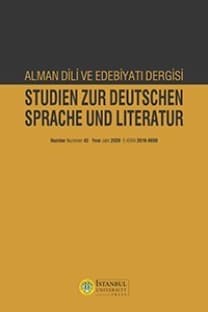The Balkan clitic doubling and its possible Equivalent in German
The Balkan clitic doubling and its possible Equivalent in German
Syntax, clitic doubling, Balkan languages, information structure scrambling,
___
- Abraham, W. (1982). Satzglieder im Deutschen. Vorschlage zur syntaktischen, semantischen und pragmatischen Fundierung. Tübingen: Narr. google scholar
- Abraham, W., & Mornarfi, L. (2002). German clause structure under discourse functional weight: Focus and antifocus. In W. Abraham und J.-W. Zwart (Eds.): Issues in Formal German(ic) Typology, (pp. 1-43). Amsterdam & Philadelphia: John Benjamins. google scholar
- Abrashi, T. (2016). Das Nahe-Distanz Modeli und die Informationsstruktur im Deutschen. In M. Jülich, Petrovic und N. Vujcic (Hrgs.), Nahe und Distanz in Sprache, Literatür und Kultur Beitrage zur 8. Jahrestagung des Südosteuropaischen Germanistenverbandes, (S. 37-54). Kragujevac: Filum. google scholar
- Artemis, A., & Anagnostopoulou, E. (1997). Toward a uniform account of scrambling and clitic doubling. In W. Abraham & E. van Gelderen (Eds.) German: Syntactic Problems- Problematic Syntax, (pp. 142-161). Tübingen: Niemeyer. google scholar
- Black, J. (1997). Clitic doubling, specificity, and Focus in Romanian. In J. Black & V. Motapanyane (Eds.), Clitics, Pronouns and Movement, (pp. 63-85). Amsterdam: John Benjamins. google scholar
- Buchholz, O. (1977). Zur Verdoppelung der Objekte im Albanischen. Berlin: Akademie der Wissenschaften der DDR. google scholar
- Buchholz, O., & Fiedler, W. (1987). Albanische Grammatik. Leipzig: Verlag Enzyklopadie. google scholar
- Çeliku, M. (2012). Sintakse e gjuhes shqipe. Tirane: Ilar. google scholar
- Duden, (2016)9. Die Grammatik. Mannheim: Dudenverlag. google scholar
- Eisenberg, P. (2013). Grundriss der deutschen Grammatik. Der Satz. Stuttgart: Metzler. google scholar
- Fortmann, C. (1997). Normalwortstellungsvarianten und ihre lexikalische Kodierung. In Groninger Arbeiten zur Germanistischen Linguistik, Nr. 41,61-76. google scholar
- Friedman, V. A. (2008). Balkan object reduplication in areal and dialectological perspective. In D. Kallulli & L. Tasmowski (Eds.), Clitic Doubling in the Balkan Languages, (pp. 25-63). Amsterdam: John Benjamins. google scholar
- Gierling, D. (1997). Clitic doubling, specificity, and Focus in Romanian. In J. Black & V. Motapanyane (Hrsg.), Clitics-Pronouns-and-Movement, (pp. 63-85). Amsterdam: John Benjamins. google scholar
- Hofmann, U. (1994). Zur Topologie im Mittelfeld : pronominale und nominale Satzglieder. Tübingen: Niemeyer. google scholar
- Höhle, T. (1982). Explikation für >normale Betonung< und >normale Wortstellung<. In W. Abraham (Hg.), Satzglieder im Deutschen, (S. 75-153). Tübingen: Narr. google scholar
- Janewa, V. (2000). Objektklitika und Informationsstruktuierung im Bulgarischen. In Linguistik Online 6/2, https:// bop.unibe.ch/linguistik-online/article/view/1005/1662 (22. Juli 2021) google scholar
- Kallulli, D. (1999). The comparative syntax of Albanian: on the contribution of syntactic types to propositional interpretation. Durham theses: Durham University, http://etheses.dur.ac.uk/1466/ (22. Juli 2021) google scholar
- Kallulli, D. (2000). Direct Object Clitic Doubling in Albanian and Greek. In F. Beukema & M. Dikken (Eds.), Clitic Phenomena in English and Other European Languages, (pp. 209-248). Amsterdam: John Benjamins. google scholar
- Kallulli, D. (2008). Clitic doubling, agreement and information structure: The case of Albanian. In D. Kallulli & L. Tasmowski (Eds.), Clitic-Doubling in the Balkan Languages, (pp. 227-256. Amsterdam: John Benjamins. google scholar
- Kallulli, D., & Tasmowski, L. (2008). Clitic doubling in the Balkan languages. Amsterdam: John Benjamins. google scholar
- Kallulli, D., & Tasmowski, L. (2008). Introduction: Clitic doubling, core syntax and the interfaces. In D. Kallulli & L.Tasmowski (Eds.), Clitic-Doubling in the Balkan Languages, (pp. 1-33). Amsterdam: John Benjamins. google scholar
- Kapia, E. (2012). Clitic doubling and information structure in Albanian. In Linguistics, An Interdisciplinary Journal of the Language Sciences, 50, (pp. 901-927). Berlin: De Gruyter Mouton. google scholar
- Lenerz, J. (1977). Zur Abfolge nominaler Satzglieder im Deutschen. Tübingen: Narr. google scholar
- Lenerz, J. (1993). Zur Syntax und Semantik deutscher Personalpronomina. In M. Reis (Hg.), Wortstellung und Informationsstruktur, (S. 117-153). Tübingen: Niemeyer. google scholar
- Lenerz, J. (2002). Scrambling and reference in German. In: W. Abraham & J.-W. Zwart (Eds.), Issues in formal German(ic) Typology, (pp. 179-192). Amsterdam: John Benjamins. google scholar
- Misevska-Tomic, O. (2000). On Clitic Sites. In F. Beukema &. Dikken (Eds.), Clitic Phenomena in English and Other European Languages, (pp. 293-316). Amsterdem: John Benjamins. google scholar
- Misevska-Tomic, O. (2004). Balkan syntax and semantics. Amsterdam: John Benjamins. google scholar
- Misevska-Tomic, O. (2008). Towards grammaticalization of clitic doubling: Clitic doubling in Macedonian and neighbouring languages. In D. Kallulli & L. Tasmowski (Eds.), Clitic Doubling in the Balkan Languages, (pp. 6588). Amsterdam: John Benjamins. google scholar
- Molnarfi, L. (2004). On Scrambling as Defocusing in German and West Germanic, In: A. Breitbarth & H. van Riemsdiejk (Eds), Triggers, (pp. 331-385). Berlin: De Gryuter. google scholar
- Pittner, K., & Berman, J. (2015)6. Deutsche Syntax: Ein Arbeitsbuch. Tübingen: Narr Francke Attempto. google scholar
- Reis, M., (Hg.), (1993). Wortstellung und Informationsstruktur. Tübingen: Niemeyer. google scholar
- Struckmeier, V. (2014). Scrambling ohne Informationsstruktur? Prosodische, semantische und syntaktische Faktoren der deutschen Wortstellung. Berlin: de Gruyter. google scholar
- Struckmeier, V. (2016). Scrambling in German Is Driven by Prosody and Semantics. In K-m. Kim, P. Umbal, T. Block, Q. Chan, T. Cheng, K. Finny, M. Katz, S. Nickel-Thompson & L. Shorten (Eds.) Proceedings of the 33rd West Coast Conference on Formal Linguistics, (pp. 381-389). Somerville, MA: Cascadilla Proceeding Projects. google scholar
- Topolinska, Z. (2014). Definiteness (Diachrony) / Bestimmtheit (Diachronie). In K. Gutschmidt, S. Kempgen, T. Berger, P. Kosta (Hrgs.) Die slavischen Sprachen, Bd.2, Handbooks of linguistics and communication science, (S. 1606-1615). Berlin: De Gruyter. google scholar
- Başlangıç: 1954
- Yayıncı: İstanbul Üniversitesi
The Balkan clitic doubling and its possible Equivalent in German
Olajumoke OYEDELE, Moses AYANKUNLE
Büchner’den Koltès’e Karşı-Kahraman: Woyzeck ve Roberto Zucco’ya Karşılaştırmalı Bir Bakış
Almanca ve Türkçe Dergi Reklamlarında Yabancı Dil Kullanımı Üzerine Karşılaştırmalı Bir İnceleme
Adolescence – Name – Internet: How Do German-Speaking Girls Name Themselves on the Web?
